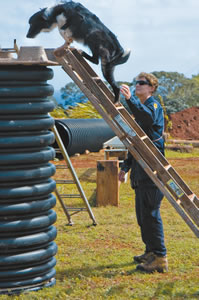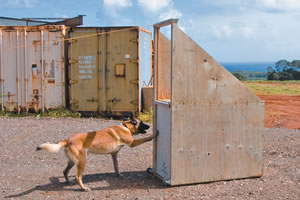To The Rescue! Woof!
For the past few weeks, there has been endless news coverage of the magnitude 7.0 earthquake that struck Haiti Jan. 12. The video footage includes incredible images of a crumbled city with countless tired volunteers working to rescue survivors or recover bodies of the dead.

By .(JavaScript must be enabled to view this email address)
E-mail this story | Print this page | Archive | RSS

|
For the past few weeks, there has been endless news coverage of the magnitude 7.0 earthquake that struck Haiti Jan. 12.
The video footage includes incredible images of a crumbled city with countless tired volunteers working to rescue survivors or recover bodies of the dead. Among these dedicated workers are search and rescue dogs, which along with their handlers are trained for these types of catastrophes.
The Hawaii State Civil Defense oversees the Urban Search and Rescue team, 86 people trained in medical, rescue, logistics, communication and search work.
Within the search element is the Urban Search and Rescue (US&R) Canine Unit, which is comprised of about 20 personnel in various stages of training on three islands (Oahu, Kauai and the Big Island), five certified dogs and another 10 dogs in training.
The state supports this team by providing training equipment, such as helmets, protective pads, technical search gear, listening devices, search cameras and microphones - similar to what we’re seeing in Haiti.
In a declared disaster, they would be deployed.

|
The dogs are individually owned by their handlers, which means day-to-day care is paid out-of-pocket.
They do not get paid for what they do. Most have full-time jobs elsewhere and meet weekly for training on their own time.
“What we’re seeing in Haiti is what these dogs are trained to do,” says Shay Walden, search element leader for the Hawaii US&R Canine Unit and works as a police officer with the Honolulu Police Department.
“Survivability in a collapsed structure, you’re looking at two to three days, and that’s not a large window of time.
“So let’s say something like that happened in Hawaii. We’re it, because until FEMA (Federal Emergency Management Agency) gets here, which you’re looking at 24 to 48 hours possibly. Within the first 24 hours it’s going to be critical for us to pinpoint and start rescue operations or else survivability is going to go way down.”
The most recent disaster to which the Hawaii US&R Canine Unit was deployed was in March 2006, when the Ka Loko Dam on Kauai breached resulting in significant property damage and the death of seven people.
“There were piles and piles of debris,” recalls Walden. “To just go in and find someone would’ve taken months, but with the dogs it narrows your focus and gives you a certain area to start pulling the pile apart.

|
“So we try to pinpoint using the dogs and then verify with technical search equipment or a verbal confirmation.”
Search and rescue dogs are trained individually for specific certifications, such as live human detection, human remains detection, and wilderness or disaster work.
The US&R Canine Unit, as well as FEMA, don’t dual-train their dogs because in a disaster situation there may be both living and dead together.
In addition to disasters, the team is often called to help with missing people cases and lost hikers, and to assist other agencies that request them, such as the Honolulu Fire Department, HPD or agencies on the Neighbor Islands.
For example, the team was called to the scene of a collapsed Kalihi home in October 2008. According to Walden, the crumbled structure was too unstable for people to go in, so the search and rescue dogs were sent in to confirm that there was no one there, alive or deceased.
Then there was the 120-foot cooling tower collapse at Hawaiian Cement last May, killing a worker who was trapped under tons of steel.
“In that situation you had a structure where you knew someone was in there, but you didn’t know if they were alive or deceased,” says Walden. “So before they started pulling it apart they wanted to know whether there was any indication of life so that how you pulled it apart made a difference.”
Dogs are often referred to as man’s best friend. Most are welcomed into homes as loving pets and, of course, also become great guard dogs. And it’s that loyalty and unique doggy brainpower that make them natural heroes.
“People say dogs smell in color,” notes Walden. “They’re able to smell way better than we are, so where we might smell beef stew they’re going to smell carrots and potatoes. They’re very scent specific.”
As more stories and pictures of the rescue and recover efforts in Haiti surface, including success stories involving search and rescue dogs, the Hawaii US&R Canine Unit is reminded on the importance of what they do and the service they offer.
“These people are unpaid professionals who dedicate their time, money and energy for something they hope never happens,” says Walden, who adds that they are always looking for more handlers and dogs.
For more information, visit www.searchandrescuehawaii.org. .(JavaScript must be enabled to view this email address)
Page 1 of 1 pages for this story
E-mail this story | Print this page | Comments (0) | Archive | RSS
Most Recent Comment(s):








